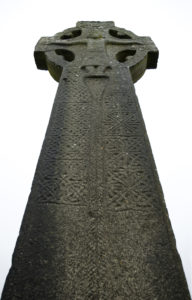
If you were raised in the Catholic faith, you might remember tales about Saint Brigid of Kildare. Stories say that as a medieval abbess and one of the patron saints of Ireland, she fed the region’s poor, healed the sick and founded several churches and institutes of learning. However, the existence of a pre-Christian Celtic goddess by the same name prompts some modern readers to wonder where her divinity ends and her sainthood begins.
Writings About Saint Brigid
The Encyclopedia Britannica emphasizes that not much is known about Brigid except through monks’ writings from the early and middle medieval period as well as texts such as “The Book of Lismore” and “Bethada Náem n-Érenn.” Several of these state that she was born into slavery in the middle of the fifth century C.E. They also tend to insist that her mother was also a slave while her father was a chieftain or nobleman. Many stories credit her with converting her Druid master to Christianity.
The Goddess’ Presence in Irish Legends
Some of the earliest known tales about the goddess Brigid appear in “Lebor Gabála Érenn,” an 11th-century collection of poetry and prose about Ireland’s mythology, and the “Cath Maige Tuired,” a 12th-century volume describing wars waged by the Tuatha Dé Danann, a race of divine or magical beings. According to legends, they were descended from an older mother goddess named Danu and inhabited Ireland before being replaced by humans. When detailing some of these legends, the Order of Bards, Ovates and Druids reveals on its own website that Brigid was one of the Tuatha Dé Danann as well as a daughter of the father deity Dagda and the war and fate goddess Morrígan.
Two Fiery Figures Fuel Creativity and Learning
Tales about Brigid of Kildare and the Celtic goddess reveal a huge number of shared characteristics between the two:
- Writing poetry and serving as patrons of poets
- Possessing healing abilities
- Having advanced wisdom and intelligence
- Encouraging study and learning
- Being a patron of blacksmiths
Both figures are strongly associated with fire. The goddess aids the flame of the metalworker as well as the “mental” flame of the poet. Some devotees see her fiery influence extending to health, fertility and the hearth and regard her as a triple fire goddess. Meanwhile, the Brigidine Sisters reference stories that the saint founded a monastery in Kildare, where a sacred flame reportedly burned in honor of the original goddess. According to some tales, the saint continued the tradition of keeping this fire burning.
Sacred Oaks and a Shared Holiday
In both the saint’s and goddess’s legends, Kildare itself may hold significance for another reason. Kildare is the anglicized form of the Irish “Cill Dara,” which means “church of the oak” in Irish. Oaks were revered by the Druids who served as scholars and priests in ancient Irish culture. Also, some linguists propose that one idiomatic translation of druid is “oak-knower.” Finally, it’s believed that oak trees were sacred to the goddess while the saint was rumored to have been born as a slave to a Druid.
Additionally, both Saint Brigid’s feast day and Imbolc are celebrated on February 1. Falling halfway between the winter solstice and spring equinox, Imbolc is a pre-Christian Celtic holiday during which candles and bonfires burned. People supplicated to the goddess Brigid for her blessings, which included protection of their herds and harvests.
The Transformation of Myths
Many figures from human history are blends of facts and mythological legends, but the jury seems to be out when it comes to Saint Brigid. Since one Celtic goddess could have transformed into an eponymous saint, both Christians and pagans throughout the world may be honoring the same woman in different forms.

